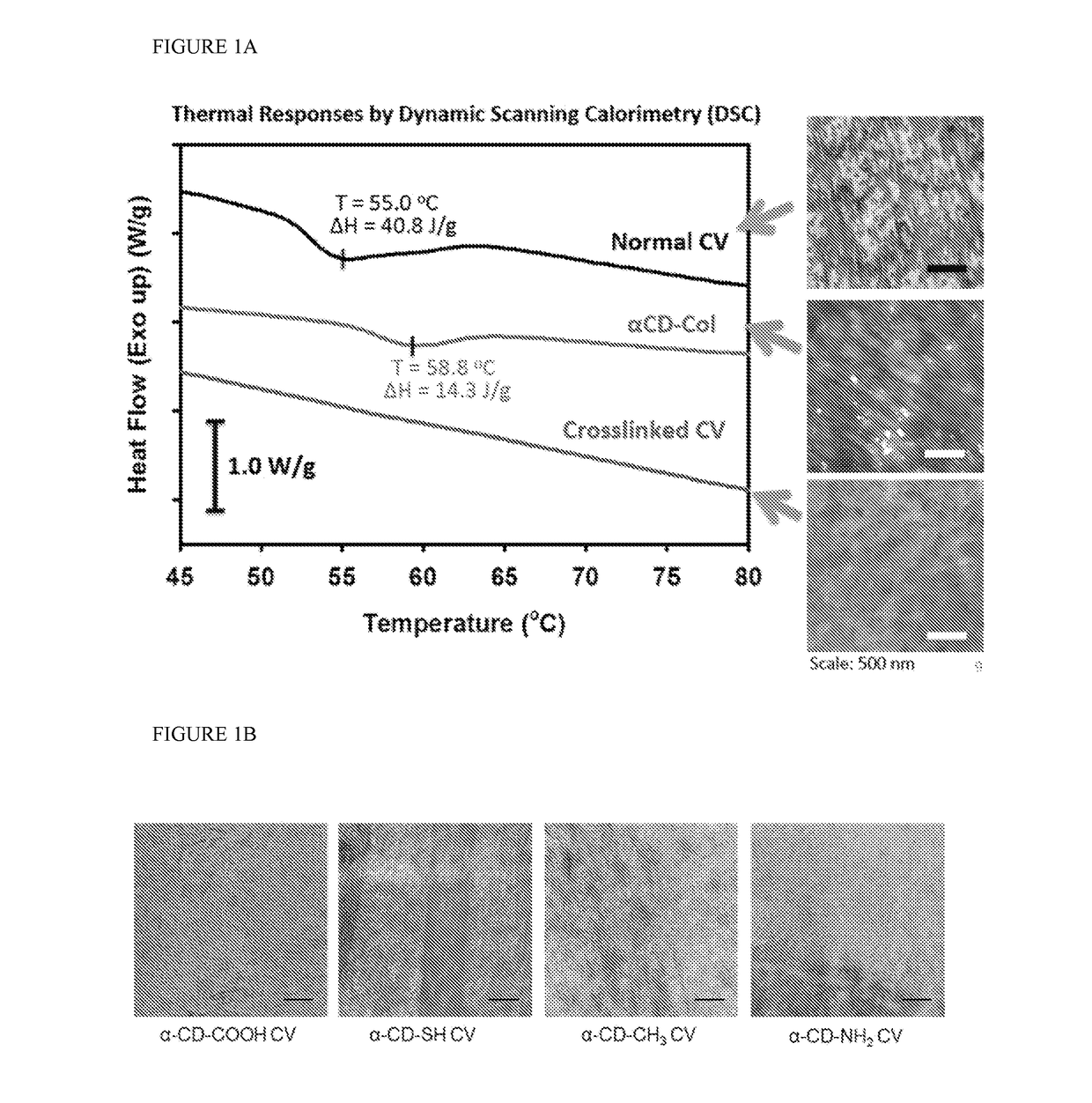Cornea mimetic biomaterials: vitrified collagen-cyclodextrin implants
a biomaterial and collagen technology, applied in the field of cornea mimetic biomaterials : vitrified collagencyclodextrin implants, can solve the problems of not all individuals can receive treatment, lack of availability, storage and distribution, remodeling or biointegration,
- Summary
- Abstract
- Description
- Claims
- Application Information
AI Technical Summary
Benefits of technology
Problems solved by technology
Method used
Image
Examples
example 1
[0082]All three cyclodextrins, especially α-CD, exhibited strong interactions with type I collagen triple helices, leading to formation of transparent and mechanically strong CD-col membranes. As shown in FIG. 1A, normal vitrigel exhibited a large and broad endothermic peak at 55° C. in the heat flow, which indicates that the collagen membrane underwent a thermal denaturation with an enthalpy of 40.8 J / g. In contrast, no discernible peak was found in the control sample of crosslinked vitrigel, suggesting a denatured feature of the collagen membrane due to the crosslinking reaction. Compared to normal vitrigel, the addition of α-CD in collagen membrane led to an increased denaturation temperature, indicating an enhanced thermal stability. Only a single narrower peak was observed in α-CD-col, which means that the matrix had a homogeneous structure. If we assume that all of the enthalpy comes from the thermal transition of collagen triple helices, the denaturation enthalpy of α-CD-col ...
example 2
[0083]Compared to conventional collagen membrane, the CD-col membranes showed greatly enhanced transparency (FIG. 2), which can be explained by the reduced collagen fibrogenesis.
[0084]Type I collagen-CD membranes were developed with optimized optical and mechanical properties for corneal regeneration. CDs represent a ring of six to eight glucose molecules with an inner hydrophobic core and an outer hydrophilic ring. All three CDs, especially α-CD, exhibited strong interactions with collagen triple helices, leading to formation of mechanically strong collagen-CD membranes. The collagen-CD membranes showed significantly higher transparency than conventional collagen membranes, which can be explained by the greatly reduced the collagen fibril diameter in collagen-CD membranes (˜20 nm) compared to conventional collagen membranes (˜80 nm). Furthermore, unlike conventional collagen membrane exhibiting a random fibrillar organization, the collagen-CD membranes demonstrated aligned fibrils ...
example 3
[0086]The inventive compositions demonstrated superior mechanical properties. When their thickness was comparable to that of human cornea (i.e. ˜500 μm), they became strong enough for suture. As shown in FIG. 3, a nylon suture was pulling through a hole in α-CD-col membrane with a thickness of 520 μm. Under the stress of suture, the hole in the thick membrane was only stretched, instead of tearing through the membrane as observed in the thin one with a thickness of 170 μm (FIG. 4).
PUM
| Property | Measurement | Unit |
|---|---|---|
| Thickness | aaaaa | aaaaa |
| Thickness | aaaaa | aaaaa |
| Transparency | aaaaa | aaaaa |
Abstract
Description
Claims
Application Information
 Login to View More
Login to View More - R&D
- Intellectual Property
- Life Sciences
- Materials
- Tech Scout
- Unparalleled Data Quality
- Higher Quality Content
- 60% Fewer Hallucinations
Browse by: Latest US Patents, China's latest patents, Technical Efficacy Thesaurus, Application Domain, Technology Topic, Popular Technical Reports.
© 2025 PatSnap. All rights reserved.Legal|Privacy policy|Modern Slavery Act Transparency Statement|Sitemap|About US| Contact US: help@patsnap.com



